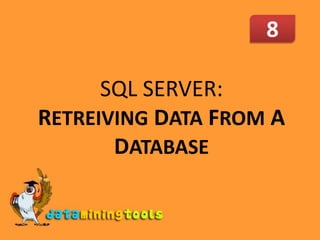SQL SERVER: WAYS TO RETRIEVE DATA
•
1 j'aime•476 vues
MS SQLSERVER:Retrieving Data From A Database
Signaler
Partager
Signaler
Partager

Recommandé
Contenu connexe
Tendances
Tendances (17)
Data Manipulation(DML) and Transaction Control (TCL) 

Data Manipulation(DML) and Transaction Control (TCL)
Database Management - Lecture 2 - SQL select, insert, update and delete

Database Management - Lecture 2 - SQL select, insert, update and delete
En vedette
En vedette (15)
MS SQL SERVER: Microsoft sequence clustering and association rules

MS SQL SERVER: Microsoft sequence clustering and association rules
MS SQL SERVER: Neural network and logistic regression

MS SQL SERVER: Neural network and logistic regression
MS SQL SERVER: Getting Started With Sql Server 2008

MS SQL SERVER: Getting Started With Sql Server 2008
Similaire à SQL SERVER: WAYS TO RETRIEVE DATA
Similaire à SQL SERVER: WAYS TO RETRIEVE DATA (20)
Its about a sql topic for basic structured query language

Its about a sql topic for basic structured query language
Les01 (retrieving data using the sql select statement)

Les01 (retrieving data using the sql select statement)
Plus de sqlserver content
Plus de sqlserver content (18)
Dernier
Dernier (20)
Transcript: New from BookNet Canada for 2024: BNC CataList - Tech Forum 2024

Transcript: New from BookNet Canada for 2024: BNC CataList - Tech Forum 2024
TrustArc Webinar - How to Build Consumer Trust Through Data Privacy

TrustArc Webinar - How to Build Consumer Trust Through Data Privacy
Unleash Your Potential - Namagunga Girls Coding Club

Unleash Your Potential - Namagunga Girls Coding Club
H2O.ai CEO/Founder: Sri Ambati Keynote at Wells Fargo Day

H2O.ai CEO/Founder: Sri Ambati Keynote at Wells Fargo Day
Nell’iperspazio con Rocket: il Framework Web di Rust!

Nell’iperspazio con Rocket: il Framework Web di Rust!
WordPress Websites for Engineers: Elevate Your Brand

WordPress Websites for Engineers: Elevate Your Brand
DSPy a system for AI to Write Prompts and Do Fine Tuning

DSPy a system for AI to Write Prompts and Do Fine Tuning
Hyperautomation and AI/ML: A Strategy for Digital Transformation Success.pdf

Hyperautomation and AI/ML: A Strategy for Digital Transformation Success.pdf
DevEX - reference for building teams, processes, and platforms

DevEX - reference for building teams, processes, and platforms
Ensuring Technical Readiness For Copilot in Microsoft 365

Ensuring Technical Readiness For Copilot in Microsoft 365
Gen AI in Business - Global Trends Report 2024.pdf

Gen AI in Business - Global Trends Report 2024.pdf
Human Factors of XR: Using Human Factors to Design XR Systems

Human Factors of XR: Using Human Factors to Design XR Systems
Powerpoint exploring the locations used in television show Time Clash

Powerpoint exploring the locations used in television show Time Clash
The Ultimate Guide to Choosing WordPress Pros and Cons

The Ultimate Guide to Choosing WordPress Pros and Cons
Dev Dives: Streamline document processing with UiPath Studio Web

Dev Dives: Streamline document processing with UiPath Studio Web
SQL SERVER: WAYS TO RETRIEVE DATA
- 1. 8 SQL SERVER: RETREIVINGDATA FROM A DATABASE
- 2. Retrieving Data from Database How to retrieve data from the given database? After creating the database structure, customizing it to fit the needs and feeding it with data, the next step is to retrieve required data for performing various operations. So how do we get these data? The answer: Just like in English language, Microsoft SQL Server also provides us the basic keyword for retrieval of data called “Select” SELECT
- 3. Select Syntax The Syntax of the select statement is simple: The basic syntax for this DML ( Data manipulation Language) command is select <fieldName1, fieldName2,…> from <table name>; This will select the appropriate columns for the given table. As it is a DML command, it is not necessary to use the keyword TABLE(,as in ‘alter table’)
- 4. Displaying the entire table What if it is needed to display all the columns? The Syntax is: select * from tablename; ‘*’, the most widely used wildcard comes to our aid. Isn’t it much better than remembering all the column names. Example: select * from student; displays the entire student table
- 6. likeselect * from tablename where <conditions>; select * from tablename where fieldNamelike <conditions>;
- 8. For string matching, use the ‘like’ keyword. Here, wild card characters(% and _)% -character represents a group(or single) of characters _ -character represents a single character Illustration: To Update cartoons whose names start with the letter ‘a’ must be given as Update cartoon set rating=100 where cartoonName = ‘a%’
- 9. LIKE explained Illustration: To Update cartoons whose names start with the letter ‘a’ and the name must of 3 characters in length: Update cartoon set rating=100 where cartoonName = ‘a__’
- 10. Filter-out duplicate selections Now, we have a problem. What if there are two records have the same data? The select command will select both the records. To avoid this the distinct keyword is used. select distinct <col> from tablename; Note: Use distinct only for a single column.
- 11. Grouping of records In SQL, it is possible to group records based on the values of a particular field. Syntax: Select * from <tableName> group by <fieldName>; Example: To display the details of students, grouped based on their class, the command will be: Select * from student group by class;
- 12. Ordering of records In SQL, it is possible to sort records based on the values of a particular field. Syntax: Select * from <tableName> order by <fieldName>; Example: To display the details of students, sorted based on their GPAs, the command will be: Select * from student order bygpa; The default ordering is ascending in nature. To make it into descending, use the desc keyword. Eg: Select * from student order bygpadesc;
- 14. Where
- 15. Like
- 16. Distinct
- 17. Group by